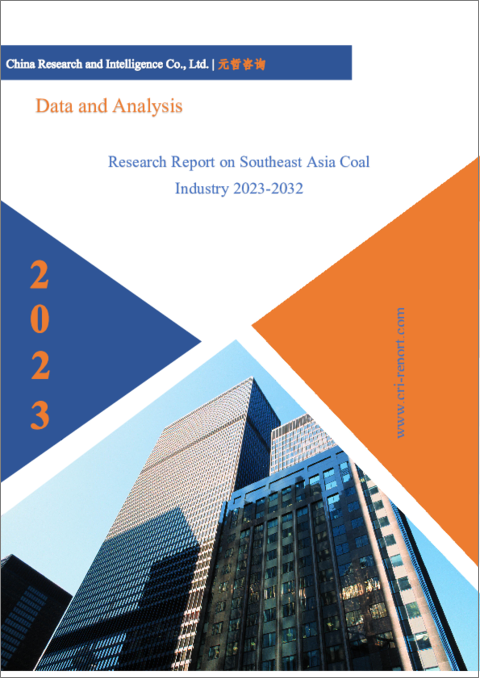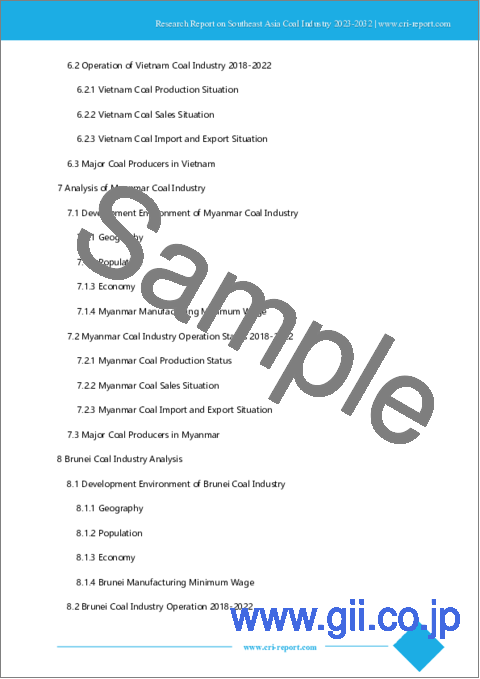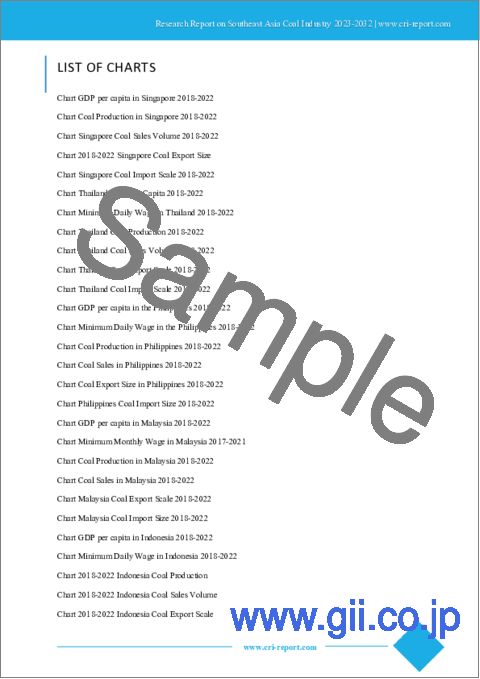|
|
市場調査レポート
商品コード
1178215
東南アジアの石炭産業の分析 (2023年~2032年)Research Report on Southeast Asia Coal Industry 2023-2032 |
||||||
| 東南アジアの石炭産業の分析 (2023年~2032年) |
|
出版日: 2022年12月28日
発行: China Research and Intelligence
ページ情報: 英文 80 Pages
納期: 即日から翌営業日
|
- 全表示
- 概要
- 目次
東南アジアの石炭資源は、主にインドネシア、タイ、ベトナム、ミャンマーなどに分布しています。中でもインドネシアは、資源量が1,000億トン以上、確認埋蔵量が200億トン以上と豊富な石炭資源を有しています。2021年、インドネシアの石炭生産量は6億1,400万トンに達しました。
製造業の発展に伴い、東南アジア諸国では電力需要が高まっており、電力供給源として石炭火力発電所の設立が急務となっています。不完全な統計によると、東南アジア諸国の石炭火力発電所の建設予定・建設中の設備容量は、中国、インドに次いで世界で3番目に大きいです。インドネシア、ベトナム、フィリピン、タイ、マレーシアは、東南アジア諸国の中で最も石炭火力発電所の設置容量が大きい国です。
東南アジアの経済成長に伴い、電力分野での石炭需要が増加し、石炭化学産業での石炭需要も増加しています。東南アジアの石炭生産量と消費量の両方が、2023年から2032年にかけて増加すると予測されています。
当レポートでは、東南アジア (シンガポール、タイ、フィリピン、マレーシア、インドネシア、ベトナム、ミャンマー、ブルネイ、ラオス、カンボジアの10ヶ国) の石炭産業について分析し、域内各国の石炭産業の発展環境や近年の動向、各国の主要企業のプロファイルと市場シェア、地域全体の今後の産業動向の見通し (2023年~2032年)、将来的な成長機会と課題、といった情報を取りまとめてお届けいたします。
目次
第1章 シンガポールの石炭産業の分析
- シンガポールの石炭産業の発展環境
- 地域
- 人口
- 経済
- シンガポールの製造業の最低賃金
- シンガポールの石炭産業の稼働状況 (2018年~2022年)
- シンガポールの石炭の生産状況
- シンガポールの石炭の販売状況
- シンガポールの石炭の輸出入状況
- シンガポールの石炭の主要メーカーの分析
第2章 タイの石炭産業の分析
第3章 フィリピンの石炭産業の分析
第4章 マレーシアの石炭産業の分析
第5章 インドネシアの石炭産業の分析
第6章 ベトナムの石炭産業の分析
第7章 ミャンマーの石炭産業の分析
第8章 ブルネイの石炭産業の分析
第9章 ラオスの石炭産業の分析
第10章 カンボジアの石炭産業の分析
第11章 東南アジアの石炭産業の見通し (2023年~2032年)
- 東南アジアの石炭産業の発展に影響を与える要因の分析
- 有利な要因
- 不利な要因
- 東南アジアの石炭産業の供給予測 (2023年~2032年)
- 東南アジアの石炭製造市場の需要予測 (2023年~2032年)
- COVID-19流行の石炭産業への影響
Coal is an important fuel, as well as an important industrial raw material. Coal is used as an energy resource, primarily burned for the production of electricity and heat, and also for industrial purposes, such as refining metals, or producing fertilizers and many chemical products.
The coal resources in Southeast Asia are mainly located in Indonesia, Thailand, Vietnam, Myanmar and other countries. Among them, Indonesia has rich coal resources with more than 100 billion tons of resources and proven reserves of more than 20 billion tons. In 2021, Indonesia's coal production reached 614 million tons.
Southeast Asia in this report includes 10 countries: Singapore, Thailand, Philippines, Malaysia, Indonesia, Vietnam, Myanmar, Brunei, Laos and Cambodia. With a total population of over 600 million by the end of 2021, Southeast Asia has an overall economic growth rate higher than the global average and is one of the key drivers of future global economic growth.
Due to the degree of economic development, technology level and other reasons, the mineral resources in Southeast Asia are less explored. However, as far as the proven resources are concerned, Southeast Asia is rich in mineral resources, and the main minerals include: copper, gold, nickel, aluminum, tin, titanium, antimony, silver, potash, gypsum, barite and phosphorus, as well as iron, zinc, lead, chromium, manganese, cobalt, kaolin, etc.
With the development of manufacturing industry, the demand for electricity in Southeast Asian countries is rising, and the establishment of coal-fired power plants is the quickest way to provide a source of electricity. According to incomplete statistics, Southeast Asian countries have the third largest installed coal-fired power plant capacity to be built and under construction in the world, after China and India. Indonesia, Vietnam and the Philippines, Thailand, and Malaysia are the countries with the highest installed coal-fired power plant capacity among all Southeast Asian countries.
As Southeast Asia's economy grows, the demand for coal in the power sector is rising, as is the demand for coal in the coal chemical industry. CRI expects both coal production and consumption in Southeast Asia to rise over the 2023-2032 period.
Topics covered:
Southeast Asia Coal Industry Status and Major Sources in 2018-2022
What is the Impact of COVID-19 on Southeast Asia Coal Industry?
Which Companies are the Major Players in Southeast Asia Coal Industry Market and What are their Competitive Benchmarks?
Key Drivers and Market Opportunities in Southeast Asia Coal Industry
What are the Key Drivers, Challenges, and Opportunities for Southeast Asia Coal Industry during 2023-2032?
What is the Expected Revenue of Southeast Asia Coal Industry during 2023-2032?
What are the Strategies Adopted by the Key Players in the Market to Increase Their Market Share in the Industry?
What are the Competitive Advantages of the Major Players in Southeast Asia Coal Industry Market?
Which Segment of Southeast Asia Coal Industry is Expected to Dominate the Market in 2032?
What are the Major Adverse Factors Facing Southeast Asia Coal Industry?
Table of Contents
1 Singapore Coal Industry Analysis
- 1.1 Singapore Coal Industry Development Environment
- 1.1.1 Geography
- 1.1.2 Population
- 1.1.3 Economy
- 1.1.4 Singapore Manufacturing Minimum Wage
- 1.2 Singapore Coal Industry Operation Status 2018-2022
- 1.2.1 Singapore Coal Production Status
- 1.2.2 Singapore Coal Sales Status
- 1.2.3 Singapore Coal Import and Export Status
- 1.3 Analysis of Major Coal Producers in Singapore
2 Analysis of Thailand Coal Industry
- 2.1 Development Environment of Thailand Coal Industry
- 2.1.1 Geography
- 2.1.2 Population
- 2.1.3 Economy
- 2.1.4 Thailand Manufacturing Minimum Wage
- 2.2 Thailand Coal Industry Operation Status 2018-2022
- 2.2.1 Thailand Coal Production Status
- 2.2.2 Thailand Coal Sales Status
- 2.2.3 Thailand Coal Import and Export Status
- 2.3 Major Coal Producers in Thailand
3 Analysis of Philippine Coal Industry
- 3.1 Development Environment of Philippine Coal Industry
- 3.1.1 Geography
- 3.1.2 Population
- 3.1.3 Economy
- 3.1.4 Minimum Wage of Philippine Manufacturing Industry
- 3.2 Philippine Coal Industry Operation Status 2018-2022
- 3.2.1 Philippine Coal Production Status
- 3.2.2 Philippine Coal Sales Status
- 3.2.3 Philippine Coal Import and Export Status
- 3.3 Major Coal Producers in the Philippines
4 Malaysia Coal Industry Analysis
- 4.1 Development Environment of Malaysia Coal Industry
- 4.1.1 Geography
- 4.1.2 Population
- 4.1.3 Economy
- 4.1.4 Malaysia Manufacturing Minimum Wage
- 4.2 Malaysia Coal Industry Operation Status 2018-2022
- 4.2.1 Malaysia Coal Production Status
- 4.2.2 Malaysia Coal Sales Status
- 4.2.3 Malaysia Coal Import and Export Status
- 4.3 Major Coal Producers in Malaysia
5 Indonesia Coal Industry Analysis
- 5.1 Development Environment of Indonesia Coal Industry
- 5.1.1 Geography
- 5.1.2 Population
- 5.1.3 Economy
- 5.1.4 Indonesia Manufacturing Minimum Wage
- 5.2 Indonesia Coal Industry Operation Status 2018-2022
- 5.2.1 Indonesia Coal Production Status
- 5.2.2 Indonesia Coal Sales Status
- 5.2.3 Indonesia Coal Import and Export Status
- 5.3 Major Coal Producers in Indonesia
6 Vietnam Coal Industry Analysis
- 6.1 Development Environment of Vietnam Coal Industry
- 6.1.1 Geography
- 6.1.2 Population
- 6.1.3 Economy
- 6.1.4 Minimum Wage of Vietnam Manufacturing Industry
- 6.2 Operation of Vietnam Coal Industry 2018-2022
- 6.2.1 Vietnam Coal Production Situation
- 6.2.2 Vietnam Coal Sales Situation
- 6.2.3 Vietnam Coal Import and Export Situation
- 6.3 Major Coal Producers in Vietnam
7 Analysis of Myanmar Coal Industry
- 7.1 Development Environment of Myanmar Coal Industry
- 7.1.1 Geography
- 7.1.2 Population
- 7.1.3 Economy
- 7.1.4 Myanmar Manufacturing Minimum Wage
- 7.2 Myanmar Coal Industry Operation Status 2018-2022
- 7.2.1 Myanmar Coal Production Status
- 7.2.2 Myanmar Coal Sales Situation
- 7.2.3 Myanmar Coal Import and Export Situation
- 7.3 Major Coal Producers in Myanmar
8 Brunei Coal Industry Analysis
- 8.1 Development Environment of Brunei Coal Industry
- 8.1.1 Geography
- 8.1.2 Population
- 8.1.3 Economy
- 8.1.4 Brunei Manufacturing Minimum Wage
- 8.2 Brunei Coal Industry Operation 2018-2022
- 8.2.1 Brunei Coal Production Status
- 8.2.2 Brunei Coal Sales Status
- 8.2.3 Brunei Coal Import and Export Status
- 8.3 Brunei Major Manufacturing Companies
9 Laos Coal Industry Analysis
- 9.1 Development Environment of Laos Coal Industry
- 9.1.1 Geography
- 9.1.2 Population
- 9.1.3 Economy
- 9.1.4 Minimum Wage of Manufacturing Industry in Laos
- 9.2 Lao Coal Industry Operation Status 2018-2022
- 9.2.1 Laos Coal Production Status
- 9.2.2 Laos Coal Sales Status
- 9.2.3 Laos Coal Import and Export Situation
- 9.3 Major Coal Producers in Laos
10 Analysis of Cambodia Coal Industry
- 10.1 Development Environment of Cambodia Coal Industry
- 10.1.1 Geography
- 10.1.2 Population
- 10.1.3 Economy
- 10.1.4 Minimum Wage of Manufacturing Industry in Cambodia
- 10.2 Cambodia Coal Industry Operation Status 2018-2022
- 10.2.1 Cambodia Coal Production Status
- 10.2.2 Cambodia Coal Sales Status
- 10.2.3 Cambodia Coal Import and Export Status
- 10.3 Major Coal Producers in Cambodia
11 Southeast Asia Coal Industry Outlook 2023-2032
- 11.1 Analysis of Factors Affecting the Development of Southeast Asia Coal Industry
- 11.1.1 Favorable Factors
- 11.1.2 Unfavorable Factors
- 11.2 Southeast Asia Coal Industry Supply Forecast 2023-2032
- 11.3 Southeast Asia Coal Manufacturing Market Demand Forecast 2023-2032
- 11.4 Impact of COVID -19 Epidemic on Coal Industry




